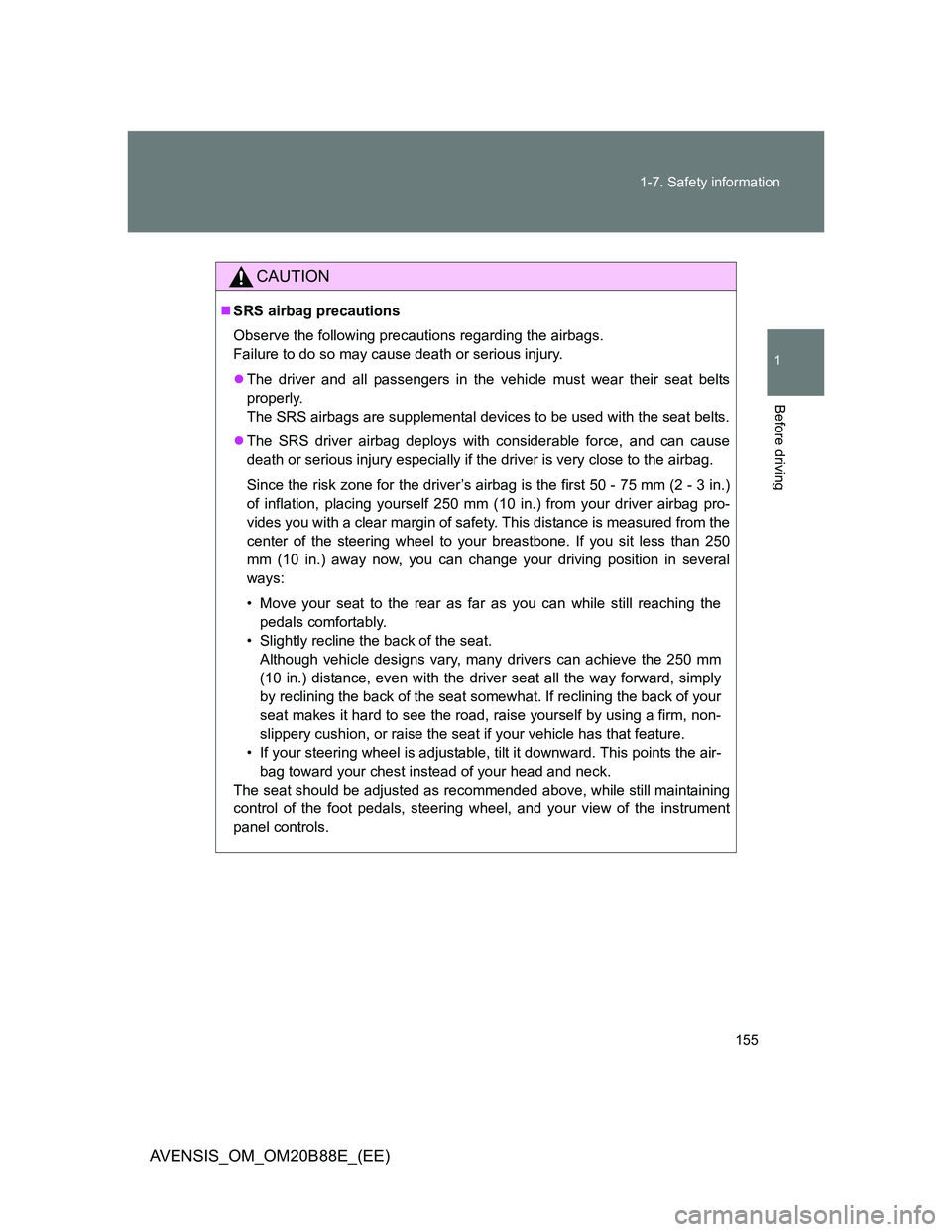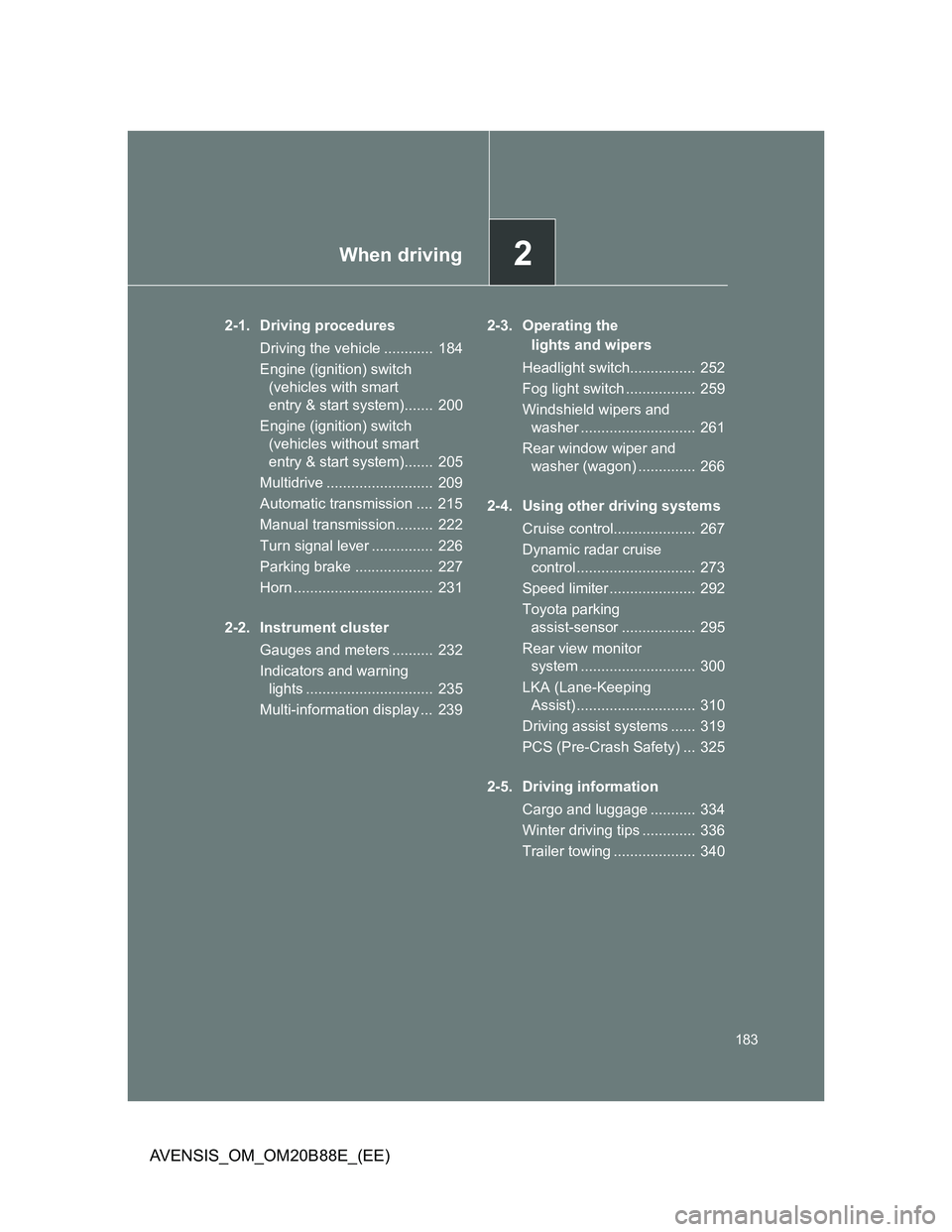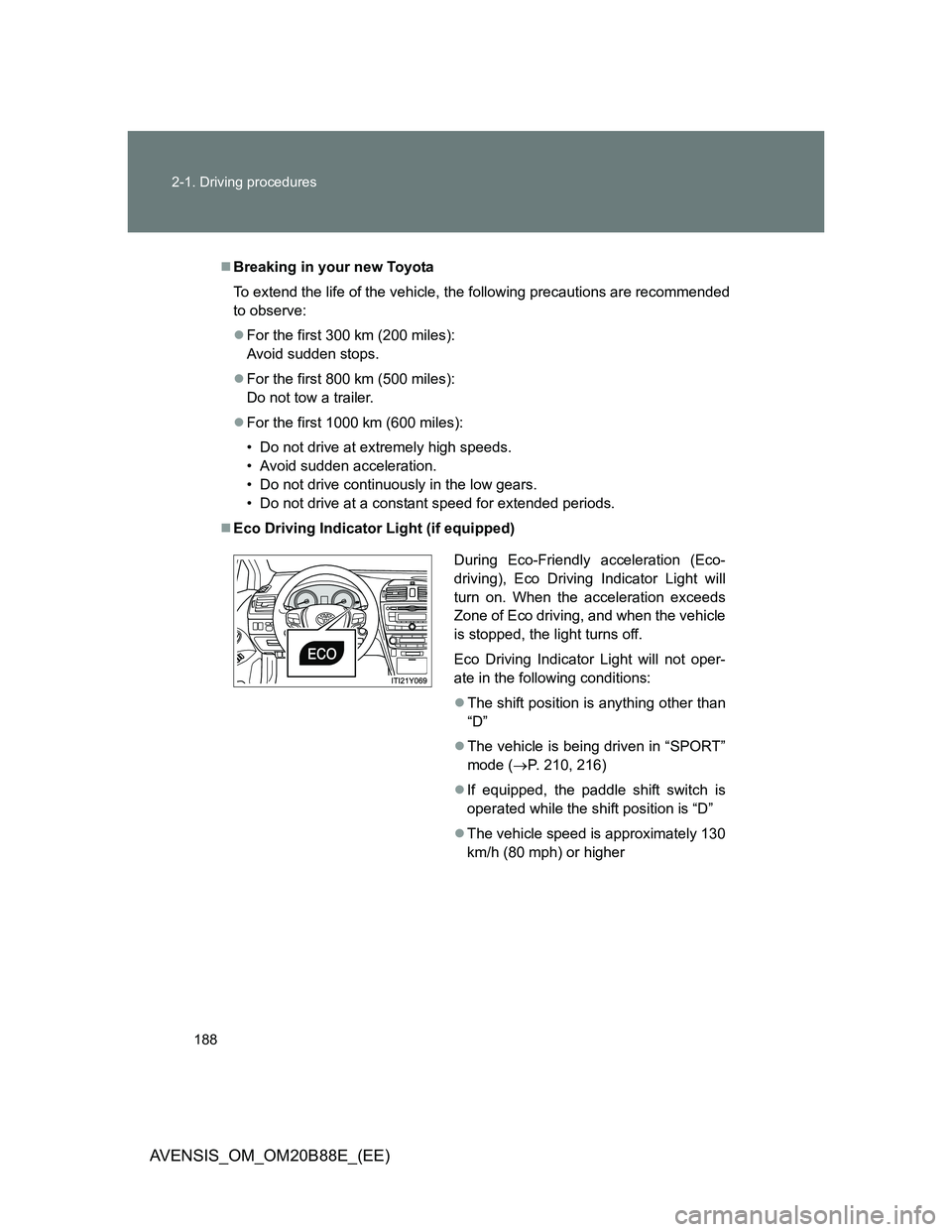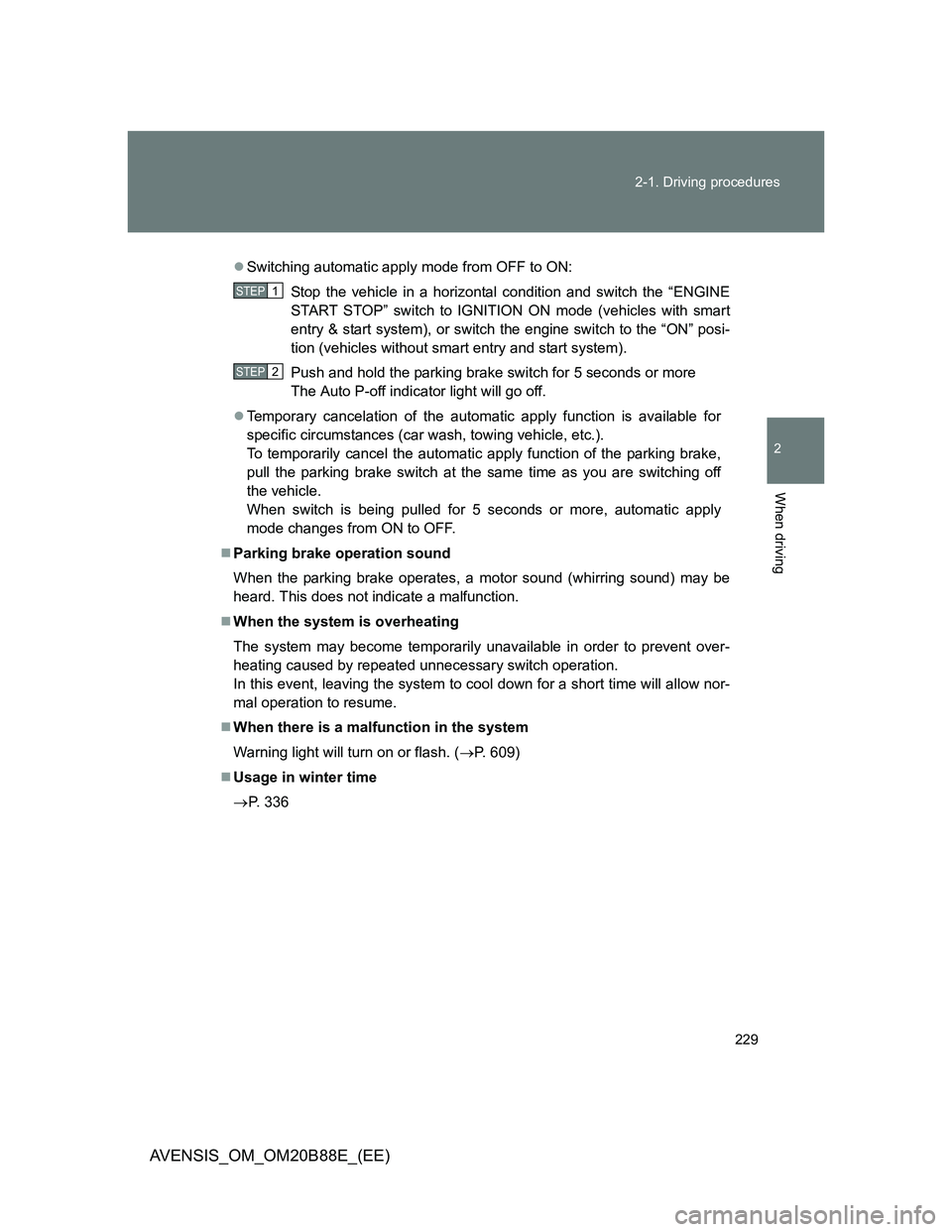Page 108 of 776
108
1-3. Adjustable components (seats, mirrors, steering wheel)
AVENSIS_OM_OM20B88E_(EE)
Steering wheel
The steering wheel can be adjusted to a comfortable position.
Power tilt & telescopic steering wheel
Up
Down
Toward the driver
Away from the driver
Manual tilt & telescopic steering wheel
Hold the steering wheel and
press the lever down.
Adjust to the ideal position by
moving the steering wheel
horizontally and vertically.
After adjustment, pull the lever
up to secure the steering
wheel.
STEP1
STEP2
Page 109 of 776
109 1-3. Adjustable components (seats, mirrors, steering wheel)
1
Before driving
AVENSIS_OM_OM20B88E_(EE)
Auto tilt away (vehicles with power tilt & telescopic steering
wheel)
When the “ENGINE START
STOP” switch is turned OFF, the
steering wheel returns to its
stowed position by moving up
and away to enable easier driver
entry and exit.
Switching to ACCESSORY or
IGNITION ON mode will return
the steering wheel to the original
position.
The power tilt & telescopic steering wheel can be operated when
The “ENGINE START STOP” switch is in ACCESSORY or IGNITION ON
mode.
Automatic adjustment of the steering position (if equipped)
A desired steering position can be entered to memory and recalled automat-
ically by the driving position memory. (P. 95)
Page 155 of 776

155 1-7. Safety information
1
Before driving
AVENSIS_OM_OM20B88E_(EE)
CAUTION
SRS airbag precautions
Observe the following precautions regarding the airbags.
Failure to do so may cause death or serious injury.
The driver and all passengers in the vehicle must wear their seat belts
properly.
The SRS airbags are supplemental devices to be used with the seat belts.
The SRS driver airbag deploys with considerable force, and can cause
death or serious injury especially if the driver is very close to the airbag.
Since the risk zone for the driver’s airbag is the first 50 - 75 mm (2 - 3 in.)
of inflation, placing yourself 250 mm (10 in.) from your driver airbag pro-
vides you with a clear margin of safety. This distance is measured from the
center of the steering wheel to your breastbone. If you sit less than 250
mm (10 in.) away now, you can change your driving position in several
ways:
• Move your seat to the rear as far as you can while still reaching the
pedals comfortably.
• Slightly recline the back of the seat.
Although vehicle designs vary, many drivers can achieve the 250 mm
(10 in.) distance, even with the driver seat all the way forward, simply
by reclining the back of the seat somewhat. If reclining the back of your
seat makes it hard to see the road, raise yourself by using a firm, non-
slippery cushion, or raise the seat if your vehicle has that feature.
• If your steering wheel is adjustable, tilt it downward. This points the air-
bag toward your chest instead of your head and neck.
The seat should be adjusted as recommended above, while still maintaining
control of the foot pedals, steering wheel, and your view of the instrument
panel controls.
Page 157 of 776
157 1-7. Safety information
1
Before driving
AVENSIS_OM_OM20B88E_(EE)
CAUTION
SRS airbag precautions
Do not lean against the door, the roof
side rail or the front, center and rear pil-
lars.
Do not allow anyone to kneel on the
passenger seats toward the door or put
their head or hands outside the vehicle.
Do not attach anything to or lean any-
thing against areas such as the dash-
board, steering wheel pad or lower
portion of the instrument panel.
These items can become projectiles
when SRS driver, front passenger and
knee airbags deploy.
Page 183 of 776

2When driving
183
AVENSIS_OM_OM20B88E_(EE)
2-1. Driving procedures
Driving the vehicle ............ 184
Engine (ignition) switch
(vehicles with smart
entry & start system)....... 200
Engine (ignition) switch
(vehicles without smart
entry & start system)....... 205
Multidrive .......................... 209
Automatic transmission .... 215
Manual transmission......... 222
Turn signal lever ............... 226
Parking brake ................... 227
Horn .................................. 231
2-2. Instrument cluster
Gauges and meters .......... 232
Indicators and warning
lights ............................... 235
Multi-information display ... 2392-3. Operating the
lights and wipers
Headlight switch................ 252
Fog light switch ................. 259
Windshield wipers and
washer ............................ 261
Rear window wiper and
washer (wagon) .............. 266
2-4. Using other driving systems
Cruise control.................... 267
Dynamic radar cruise
control ............................. 273
Speed limiter ..................... 292
Toyota parking
assist-sensor .................. 295
Rear view monitor
system ............................ 300
LKA (Lane-Keeping
Assist) ............................. 310
Driving assist systems ...... 319
PCS (Pre-Crash Safety) ... 325
2-5. Driving information
Cargo and luggage ........... 334
Winter driving tips ............. 336
Trailer towing .................... 340
Page 188 of 776

188 2-1. Driving procedures
AVENSIS_OM_OM20B88E_(EE)
Breaking in your new Toyota
To extend the life of the vehicle, the following precautions are recommended
to observe:
For the first 300 km (200 miles):
Avoid sudden stops.
For the first 800 km (500 miles):
Do not tow a trailer.
For the first 1000 km (600 miles):
• Do not drive at extremely high speeds.
• Avoid sudden acceleration.
• Do not drive continuously in the low gears.
• Do not drive at a constant speed for extended periods.
Eco Driving Indicator Light (if equipped)
During Eco-Friendly acceleration (Eco-
driving), Eco Driving Indicator Light will
turn on. When the acceleration exceeds
Zone of Eco driving, and when the vehicle
is stopped, the light turns off.
Eco Driving Indicator Light will not oper-
ate in the following conditions:
The shift position is anything other than
“D”
The vehicle is being driven in “SPORT”
mode (P. 210, 216)
If equipped, the paddle shift switch is
operated while the shift position is “D”
The vehicle speed is approximately 130
km/h (80 mph) or higher
Page 229 of 776

229 2-1. Driving procedures
2
When driving
AVENSIS_OM_OM20B88E_(EE)
Switching automatic apply mode from OFF to ON:
Stop the vehicle in a horizontal condition and switch the “ENGINE
START STOP” switch to IGNITION ON mode (vehicles with smart
entry & start system), or switch the engine switch to the “ON” posi-
tion (vehicles without smart entry and start system).
Push and hold the parking brake switch for 5 seconds or more
The Auto P-off indicator light will go off.
Temporary cancelation of the automatic apply function is available for
specific circumstances (car wash, towing vehicle, etc.).
To temporarily cancel the automatic apply function of the parking brake,
pull the parking brake switch at the same time as you are switching off
the vehicle.
When switch is being pulled for 5 seconds or more, automatic apply
mode changes from ON to OFF.
Parking brake operation sound
When the parking brake operates, a motor sound (whirring sound) may be
heard. This does not indicate a malfunction.
When the system is overheating
The system may become temporarily unavailable in order to prevent over-
heating caused by repeated unnecessary switch operation.
In this event, leaving the system to cool down for a short time will allow nor-
mal operation to resume.
When there is a malfunction in the system
Warning light will turn on or flash. (P. 609)
Usage in winter time
P. 336
STEP1
STEP2
Page 253 of 776
253 2-3. Operating the lights and wipers
2
When driving
AVENSIS_OM_OM20B88E_(EE)
Turning on the high beam headlights
With the headlights on, push
the lever forward to turn on the
high beams.
Pull the lever back to the center
position to turn the high beams
off.
Pull the lever toward you to
turn on the high beams.
Release the lever to turn them off.
You can flash the high beams
with the headlights on or off.
AFS (vehicles with discharge headlights)
AFS (Adaptive Front-lighting System) improves visibility at intersec-
tions and or curves by automatically adjusting the level of the head-
lights according to vehicle speed and the degree of the tire angle that
are controlled by steering input.
Operates at speed of 10 km/h (6 mph) or higher.
Deactivating AFS
Press the switch to deactivate
the AFS.